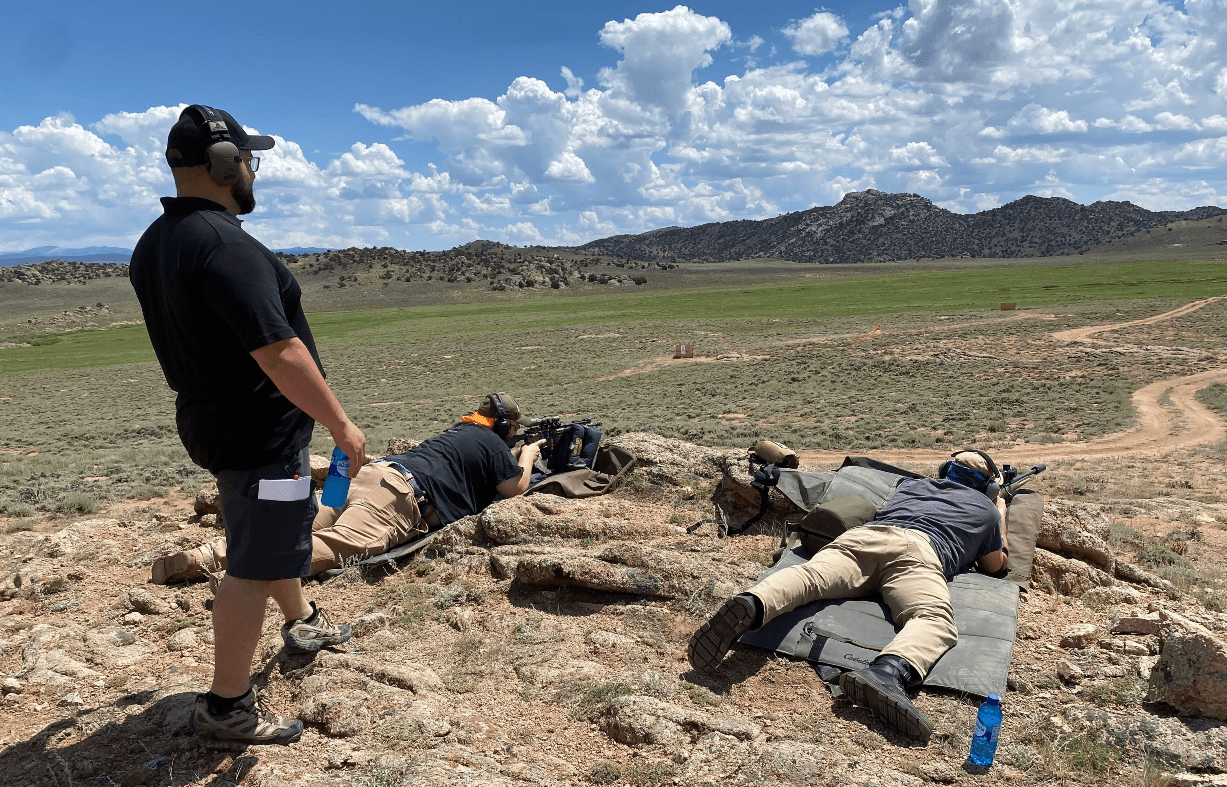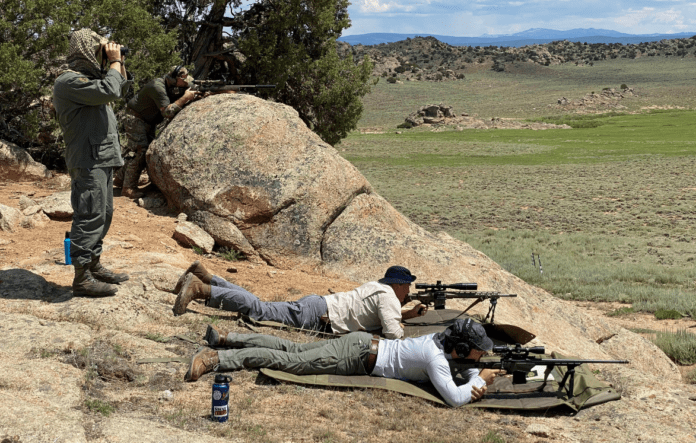“What exactly do you consider to be long range?” That’s a good question and it is truly subjective. If you have a Ruger 10/22 in your hands, 100 yards is long range. If you’re shooting at a whitetail with a Remington 870 loaded with slugs, an 87 yard shot is long range.
However, when you move west of the Mississippi River and the country starts to open up, long range with centerfire rifles doesn’t even begin until you are farther than 300 yards. Some would argue that long range doesn’t start until you are past 500 yards.
Regardless of your definition of what “long range” shooting happens to be, I think we can all agree that the primary goal of rifle marksmanship is to be able to hit your target with the first shot, on demand, regardless of the conditions or the distance. Such is the stated goal of the High Elevation Precision Rifle class put on by Student of the Gun each summer in wonderful Wyoming.

What Constitutes ‘High Elevation’?
When we say our rifle class is a “high elevation” course, we’re talking about geography or distance above sea level. There’s a good bit of science involved in precision rifle shooting and one factor that cannot be ignored is atmospheric pressure or for the layman “heavy or thin air.” The air is thinner the higher you climb.
There’s a valid reason why ballistic calculator apps want you to input the elevation. Additionally, there’s a good reason why five of the top 10 world record sniper kills were taken in Afghanistan.
To put it simply, you can do things with rifle bullets at higher elevation that you can’t do with bullets at sea level. Also, in the west, where the climate is generally much drier than the east or south, mirage is less of a distraction.
At the Spur Ranch in Wyoming, the rifle range is located at 7300 feet above sea level. This definitely qualifies as “high elevation” and we can get more performance out of rifle bullets, all things being equal, than would be possible east of the Mississippi or on the coasts.
For example, according to the Hornady Ballistic Calculator app, a 168 grain bullet traveling 2600 fps from the muzzle will be going 1215 fps at 1000 yards at 100 feet above sea level. Using the same specs, that bullet will be going 1578 fps at 1000 yards at 7300 feet above sea level. The longer you can keep your rifle bullets traveling at supersonic speeds, the farther you can make reliable and predictable hits on target. When rifle bullets drop below supersonic, predictable impacts or shot adjustments becomes a crap shoot.
Every American is a Rifleman
In the Marine Corps, one of their mottos is that “Every Marine is a rifleman.” Even cooks and aircraft mechanics in the Corps are required to qualify with the service rifle at boot camp and again annually.
If you have a working understanding of the history of the United States of America, you will understand that this nation was founded by riflemen. We believe that it’s the birthright and duty of every American citizen to be a skilled rifleman. This is an anomaly to the rest of the world.
Through the High Elevation Precision Rifle course, we provide citizens with the opportunity to bring their rifle/scope/ammo combination to a class and a range to which few people have access. The number of 1000-yard ranges east of the Mississippi is small. The number of one mile ranges is even smaller. In Wyoming, we have a range that stretches to 1.5 miles.
What Rifle Do I Need?
While many shooters will choose to bring a higher end rifle with expensive optics to the course, a multi-thousand dollar rig isn’t required. During the latest class, a student used a Ruger Ranch rifle chambered in .223 Remington with a Black Spider Optics 1-4x scope. That combination cost well under $1000. He was able to successfully and repeatedly hit targets on demand out to 500 yards.

Previously, we had a student who purchased an inexpensive Savage .308 Winchester rifle and combined it with a scope that cost him around $300. Again, gear that was well under the $1000 range. He was able to engage targets successfully and repeatedly out to 800 yards.
Conversely, some folks with more disposable income will spend more and reach out farther. During the summer of 2022, a student brought a Barrett MRAD rifle chambered in .338 Lapua Magnum. He reached out to 1000 and 1400 yards, then moved on to one mile. On the last day he got a “confirmed kill” on the 1.5 mile target.
During our latest course, those who brought 6.5 Creedmoor rifles were able to successfully score hits at 1000, 1400, and 1 mile. This despite having to deal with unpredictable wind conditions.

Regardless of the hardware, every student achieved more than they had ever done before and left with a genuine confidence, not only in their gear, but in their own abilities. That’s the primary purpose of the training.
Fundamental Rifle Marksmanship
Regardless of the amount of money you spend on gear, the ballistic calculator you use or the match grade ammunition you buy, the “X” factor is the shooter. We can’t purchase our way around fundamental marksmanship skills and that’s the foundation upon which we build the course.
Every shooter is admonished at the very beginning of the class that, “If you can’t group three rounds into an inch at 100 yards, you’re wasting your time and ammo shooting at 1000 yards.”
In addition to engaging targets from 100 yards to 1000 yards, students also participate in challenging exercises. One of these stages requires them to locate targets at unknown distances, estimate the range, and then engage them successfully.
Student of the Gun University
Paul Markel is a United States Marine combat veteran who has been teaching Small Arms & Tactics for over thirty years. His son, Jarrad, is his primary assistant and has been coaching the High Elevation Precision Rifle class since 2017. Student of the Gun University is the training arm of SOTG. Each student receives the “Precision Rifle Range Book” with enrollment. This text is also available on Amazon.com.
In addition to long range rifle, they offer pistol, carbine, shotgun, and traumatic medical courses. Interested parties should follow the link and sign up to receive notifications as the training calendar is updated. Remember, you are a beginner once, a student for life.






300 yards is my max at my age. I have a .243 Ruger American with a Redfield scope. Comfortably under a grand. But I have no doubt that a younger shooter could take that combo easily to 500. Maybe further.
I may be done hunting. The next year will tell. If so that rifle and glass will go to a grandson, who is just starting. Sad to realize I’m coming to the end. But fun to watch the youngsters getting started.
.308 is more than i need, esp. ’round here.
in montana, that creedmore stuff starts making sense.
As someone from Montana, I would say the .308 Win with a contemporary load still dunks on the 6.5Creed up until around 600 meters then it makes more sense to go with a 6.5 CM for shots past that.
“If you can’t group three rounds into an inch at 100 yards, you’re wasting your time and ammo shooting at 1000 yards.”
Pretty much sums it up. My long range rifle is a rare 25-06 Sendero black fluted with a Leupold 3.5-10 tactical scope, 6-9″ Harris bipod. It will do what I ask it.
I would own a top shelf Barrett if I was a self serving pos not pulling the wagon to Defend The 2A, those funds went to the NRA to buy wayne some suits…Never again. If Defining Gun Control by its History is not a priority no org. gets a dime from me.
🍿
void = 💩
Just here for the comments.
void…What happened void? Some adult read your replies to me and gave you a time out or a swift kick in the pants?
Nope just lost a bet regarding a tarbaby.
I get it is an interesting concept.
I learned a lot about air density when shooting NRA High Power in the deep, deep south. The humidity was so thick the guys shooting 5.56/.223 saw their hits key holing.
Be nice to shoot out that far, around here, 200-300yrds with a clear line of sight is normal with a few places across a corn field might get out to 500yrds. Otherwise rolling hills and dense wood lots.
Scaled down targets and a .22 might be more realistic.
Try a timberland pipeline, powerline easement.
I would rather not shoot on someone else property without their permission. Pretty sure the power company would not be to keen on that either.
Excellent article!
One factor that few people understand is that the drag coefficient or ballistic coefficient of any bullet will vary with velocity. Most ballistic calculator programs (including Hornady’s on line calculator), are predicated on the presumption that the drag coefficient and ballistic coefficient remain constant with range and velocity. This enables them to “calculate” remaining velocity as a simplified exponential decay function. This is best described as reasonably accurate. However; once one attempts truly long range shooting, the presumption that drag coefficient remains constant with velocity becomes problematic.
This article explains the issues well.
https://badlandsprecision.com/bullet-drag-explained/
Many bullet manufacturers are aware of the issue of inconstant drag coefficient. Most attempt to measure and publish values that are appropriate for the velocity ranges that are pertinent for most shooters. While I have written computer programs that can calculate remaining velocity along with bullet drop and windage based on inconstant drag coefficient, such a program is not particularly useful unless one has a supersonic wind tunnel.
As an aside, the fact that drag coefficient varies the most in the transonic velocity regime explains why shotguns and most handguns are not particularly accurate beyond close range. The muzzle velocity of shotguns and handguns tend to be barely supersonic. The drag coefficient of their projectiles is extremely variable. Buckshot that has been deformed by passage through a choke is even more problematic.
At the end of the day, you need to practice shooting at varying ranges and elevations to develop your own ballistics table.
One note of interest, the 7th longest shot was taken by Gunnery Sergent Carlos Hathchcock II, in Vietnam Feb 1967 at 2,286 meters off a Browning M2 with a 8X Unertl scope.
No ballistics app.
No hand held wind meter.
No fancy scope with a Christmas tree like reticle.
That record stood for 35 years.
Hathcock was a damn marvel. 93 confirmed kills, including the famous sniper on sniper duel where he shot a top NVA sniper sent specifically to kill Hathcock by shooting his opponent in the eye — through his scope!
But then. . . there was Simo Häyhä, the Finnish soldier known to the Russians as “the White Death” — who had over **500** confirmed kills. The Russians eventually were so afraid of him that they eventually launched artillery barrages to try and get rid of him. He could hit a target at 150 meters 16 times in one minute using a Mosin — which, of course, only holds 5 rounds at a time.
Comments are closed.